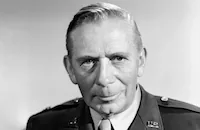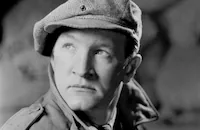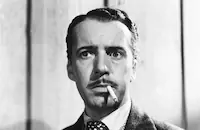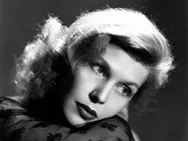Ruth Gordon was also an accomplished actress (Harold and Maude, Rosemary's Baby) and had been working in the theater since 1915. Garson Kanin said that he frequently deferred to her on the subject of theater lore. The first title for their screenplay was The Art of Murder, which the Breen office rejected. It was for a time also called Imagination. The accomplished George Cukor, another veteran from the theater, took on the directing responsibilities. Laurence Olivier and Cary Grant were the first stars approached to play the lead role.
A Double Life is set in the real Broadway scene, where hungry actors trade gossip on the sidewalks while a fortunate few work hard to create popular attractions. An independent star that chooses his productions, Anthony "Tony" John (Ronald Colman) is liked and admired by his associates. But his habit of identifying too strongly with the characters he plays has made him alienated and unhappy. Tony would like to get back together with his co-star and ex-wife Brita (Signe Hasso), but she's wary of the emotional roller coaster. Tony is fine when performing in a comedy, but can be a real pain when he's involved in a heavy drama. Already jealous of Brita's popularity with his associates, especially publicist Bill Friend (Edmond O'Brien), Tony takes the lead role in Othello, and begins a downward slide into true psychosis. An unlucky acquaintance along the way is waitress Pat Kroll (Shelley Winters), who has no idea that her new 'contact' is a top celebrity.
Gordon and Kanin's story of a murderously obsessive actor succeeds because it dramatizes the primary illusion of theater, the construction of an entertaining fictitious reality. Anthony John is a closet paranoid folding up on himself. He's so emotionally 'into' his performances that he can confuse drama and real life. It's a clever extrapolation of the actor's situation. It's not difficult for people in show biz to believe that their profession allows them to live a fantasy. Tony seems convinced of an unavoidable Fate that fixes A Double Life firmly in the film noir universe.
Ronald Colman's performance is suspenseful in itself. In less stressful settings Tony John is warm and giving to his confederates, so we continue to empathize with him when he drifts into mania. Dramatically, there are some shrewd turns here, as the actor's stage performances express all of the inner anguish and grief that the 'man behind the greasepaint' cannot express in real life. The gimmick becomes more than a tricky noir plot twist. What if an actor went crazy and really did try to play an on-stage murder scene for real? The script allows Colman to build slowly to his fits of insanity, hearing weird noises and bells in his ears and disembodied dialogue from the play. When the unlucky Pat merges into his illusion of Desdemona, he's already reciting lines "in character" as a murderer. Considering Colman's utterly convincing stage presence it is interesting to note that he had never acted in a Shakespeare play.
Beautiful Swedish star Signe Hasso's most memorable Hollywood role had been as a Nazi spy in the docu-noir The House on 92nd Street. Her Brita conveys the real-life situation of an actress playing opposite her former spouse; writers Gordon and Kanin use the practical, thoughtful Brita to anchor the story. Edmond O'Brien's publicist adds yet another layer of 'performance' to the storyline when he arranges for an actress to prove that his romantic rival is a murderer. The publicist's plan to flush out a concealed maniac not only makes sense, it becomes a little play of its own. The next film to so successfully blend 'acting' with crime, is the underrated Phil Karlson noir 99 River Street.
Twenty-six year-old Shelley Winters had just won the role of Ado Annie for Oklahoma! on Broadway and had to ask for release time to act for director Cukor. The vulnerable Pat Kroll was one of her first credited movie parts. The '40s must have been a rough ride for Ms. Winters, for she played a long string of unbilled bit appearances before this Big Break, and followed with more of the same. She surely knew as much as anybody about the reality of Hollywood Starlets in the studio system.
The film uses a surfeit of familiar performers in smaller roles. Millard Mitchell and Whit Bissell play a reporter and a coroner and noir staple Art Smith is a wigmaker. Theatrical notables Fay Kanin and Paddy Chayefsky have small bits. Nick Dennis (Kiss Me Deadly) is a stagehand, and John Derek has a bit as a police stenographer. Finally, the beloved Betsy Blair (Marty) makes an early impression as a hopeful actress over-eager to get hired for Edmond O'Brien's sting operation.
The handsome production values show in every scene. Director George Cukor engaged Walter Hampden, the "Dean of the American Theater" to direct the Othello excerpts, which were praised for their realism. Exteriors in New York centered on the Empire Theater, while the theater interiors used Universal's famous Stage 28, home of the still-standing set from the silent-era The Phantom of the Opera. Miklos Rosza's expressive score strays from his usual noir riffs into more romantic moods. It earned for the composer the second of his three Oscars.
Olive Films' Blu-ray of A Double Life is one of the best-looking vintage B&W Blu-rays out there. The nearly immaculate transfer has retained the natural textures and shadings of Milton Krasner's cinematography. Now often referred to as 'film grain', this pleasing filmic texture makes Krasner's dusty afternoon interiors and low-key night lighting even more vibrant. During the performance scenes stage lights are allowed to shine directly into the camera, adding another level of stylization.
The beautiful condition of this release is all the more remarkable considering A Double Life's vagabond history. Independently produced by Garson's brother Michael Kanin and originally distributed by Universal, the title was one of many contracted to Republic Pictures before that entire library was absorbed by Paramount. Only now can the public see this particular title and other 'orphaned' Republic acquisitions in quality video presentations.
by Randy Haberkamp for an August 2010 screening
For more information about A Double Life, visit Olive Films.
by Glenn Erickson



































